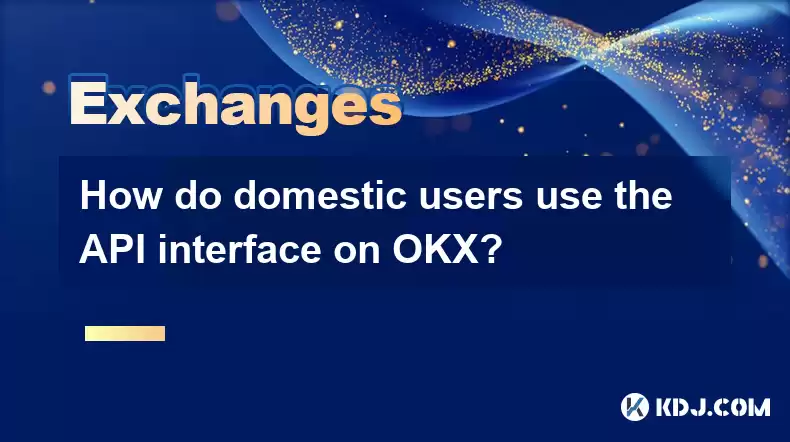-
 bitcoin
bitcoin $87959.907984 USD
1.34% -
 ethereum
ethereum $2920.497338 USD
3.04% -
 tether
tether $0.999775 USD
0.00% -
 xrp
xrp $2.237324 USD
8.12% -
 bnb
bnb $860.243768 USD
0.90% -
 solana
solana $138.089498 USD
5.43% -
 usd-coin
usd-coin $0.999807 USD
0.01% -
 tron
tron $0.272801 USD
-1.53% -
 dogecoin
dogecoin $0.150904 USD
2.96% -
 cardano
cardano $0.421635 USD
1.97% -
 hyperliquid
hyperliquid $32.152445 USD
2.23% -
 bitcoin-cash
bitcoin-cash $533.301069 USD
-1.94% -
 chainlink
chainlink $12.953417 USD
2.68% -
 unus-sed-leo
unus-sed-leo $9.535951 USD
0.73% -
 zcash
zcash $521.483386 USD
-2.87%
How do domestic users use the API interface on OKX?
OKX API usage requires understanding key generation, authentication (primarily API key-based), permission levels, and handling errors/rate limits. Domestic users must also comply with local cryptocurrency regulations.
Mar 22, 2025 at 10:35 pm

- Understanding OKX API Keys and Permissions
- Accessing and Generating API Keys on OKX
- Authentication Methods for OKX API
- Common API Endpoints and Usage Examples
- Handling Errors and Rate Limits
- Security Best Practices for OKX API Usage
- Specific Considerations for Domestic Users
Accessing and utilizing the OKX API for cryptocurrency trading requires a nuanced understanding of API keys, authentication, and specific considerations for domestic users in various jurisdictions. This article outlines the process, addressing potential challenges and security concerns.
Obtaining and Managing Your OKX API Keys:Before interacting with the OKX API, you need to generate API keys. This involves logging into your OKX account and navigating to the API management section. Here, you'll create a new key pair, consisting of a public key and a private key. Never share your private key with anyone. Treat it like your password. You can also set specific permissions for your API key, restricting its access to certain functionalities. This granular control helps mitigate risk.
Understanding API Key Permissions:OKX offers different levels of permission for API keys. These permissions control what actions the API key can perform. For example, a key might be limited to only retrieving account information, or it could be granted full trading authority. Carefully consider the required permissions before generating your API keys. Only grant the minimum necessary permissions to reduce potential security vulnerabilities. Always review and adjust permissions as your needs evolve.
Authentication Methods:OKX primarily uses API key authentication. This involves including your API key and secret in your API requests. The exact implementation varies depending on the API endpoint and the programming language you're using. Libraries are available for popular languages like Python and JavaScript to simplify the authentication process. Always prioritize secure methods for handling your API credentials.
Common API Endpoints and Usage Examples:The OKX API offers a range of endpoints covering various functionalities. These include retrieving account balances, placing orders, fetching market data, and managing your trading positions. The OKX documentation provides detailed explanations of each endpoint, including request parameters and response formats. For example, to get your account balance, you'd use a specific endpoint with your API key. To place an order, you'd specify the trading pair, order type, quantity, and price.
Handling Errors and Rate Limits:The OKX API may return errors for various reasons, such as invalid requests, insufficient funds, or network issues. Proper error handling is crucial for robust API integration. The API also has rate limits to prevent abuse. Exceeding these limits may result in temporary suspensions. Understanding and respecting these limits is essential for reliable operation. Implement strategies to handle errors gracefully and avoid exceeding rate limits.
Security Best Practices:Security is paramount when using any API, especially for cryptocurrency trading. Never hardcode your API keys directly into your application code. Use environment variables or secure configuration mechanisms. Regularly rotate your API keys to minimize the impact of potential compromises. Use HTTPS for all API communication to protect your data from eavesdropping. Employ robust input validation to prevent injection attacks. Keep your API client software updated to benefit from the latest security patches.
Considerations for Domestic Users:Domestic regulations vary widely. Users should be aware of any restrictions or requirements imposed by their local authorities regarding cryptocurrency trading and API usage. Compliance with local laws is crucial to avoid legal complications. OKX may also have specific terms of service that apply to users in different regions. Carefully review these terms before using the API.
Common Questions and Answers:Q: What programming languages are supported by the OKX API?A: The OKX API is generally language-agnostic; you can use any language with HTTP request capabilities. However, community-maintained libraries exist for popular languages like Python, JavaScript, and others, simplifying the development process.
Q: How do I handle API key revocation?A: If you suspect your API key has been compromised, immediately revoke it through the OKX API management interface. Generate a new key pair and update your applications accordingly.
Q: What are the common errors encountered when using the OKX API?A: Common errors include authentication failures (incorrect API keys), insufficient funds, invalid order parameters, and rate limit exceeding. The OKX API documentation provides detailed error codes and their meanings.
Q: Are there any specific limitations for domestic users in accessing the OKX API?A: Access to the OKX API itself is generally not restricted based on location, but domestic regulations regarding cryptocurrency trading might apply. Users must comply with all applicable laws in their jurisdiction.
Q: How can I test my API integration before using it with real funds?A: OKX might offer a sandbox environment or testnet, allowing you to test your API integration with simulated funds. Alternatively, you can start with small test trades using real funds to verify your implementation.
Q: What if I experience technical difficulties with the OKX API?A: OKX typically provides support channels (e.g., email, online help center) to assist with technical issues. Their documentation may also offer troubleshooting tips and FAQs. Review their support resources for assistance.
Q: How often should I rotate my API keys?A: There's no strict timeframe; however, it's best practice to rotate your API keys regularly, for example, every few months, or after any suspected security incident. This limits the potential damage from a compromised key.
Disclaimer:info@kdj.com
The information provided is not trading advice. kdj.com does not assume any responsibility for any investments made based on the information provided in this article. Cryptocurrencies are highly volatile and it is highly recommended that you invest with caution after thorough research!
If you believe that the content used on this website infringes your copyright, please contact us immediately (info@kdj.com) and we will delete it promptly.
- Big Bets on the Blockchain: Coinbase Teams Up with Kalshi for Prediction Market Push
- 2025-12-14 15:50:02
- ZRO Token Unlocking Event: Analyzing Circulating Supply Dynamics and Market Impact
- 2025-12-14 15:55:01
- Hong Kong's Elusive Coin Carts: Many Residents Still Awaiting Their Change
- 2025-12-14 15:50:02
- Bitcoin Brace for Impact? Analyst Flags Potential Retest of $85,000 Amidst Volatility
- 2025-12-14 15:45:01
- Unearthing Riches: The Unusual Penny Coin Worth Over £2,000
- 2025-12-14 12:45:01
- Trump's Unforgettable Coin Toss Steals the Show at the Army-Navy Game
- 2025-12-14 15:45:01
Related knowledge

What does it mean to "Hedge" a position on Bybit and how do I do it?
Dec 11,2025 at 07:00pm
Understanding Position Hedging on Bybit1. Hedging on Bybit refers to opening opposing positions in the same trading pair to reduce exposure to adverse...

How to secure my Bybit account against phishing and scams?
Dec 12,2025 at 11:39am
Enable Two-Factor Authentication (2FA)1. Log in to your Bybit account and navigate to the Security Settings section. 2. Select Google Authenticator or...

How to convert small balances ("dust") to another coin on Bybit?
Dec 07,2025 at 08:59pm
Understanding Dust Conversion on Bybit1. Dust refers to tiny, non-withdrawable balances of cryptocurrencies left in a user’s spot wallet after partial...

What are subaccounts on Bybit and why would I need to use one?
Dec 14,2025 at 06:00pm
Understanding Subaccounts on Bybit1. Subaccounts on Bybit are independent trading entities linked under a single master account, each with its own uni...

Why is the Bybit app not working or showing a connection error?
Dec 07,2025 at 06:00pm
Troubleshooting Network Configuration Issues1. The Bybit app relies heavily on stable internet connectivity to synchronize real-time market data and e...

How to use limit and conditional orders on the Bybit platform?
Dec 10,2025 at 04:19am
Understanding Limit Orders on Bybit1. A limit order allows traders to specify the exact price at which they wish to buy or sell a cryptocurrency asset...

What does it mean to "Hedge" a position on Bybit and how do I do it?
Dec 11,2025 at 07:00pm
Understanding Position Hedging on Bybit1. Hedging on Bybit refers to opening opposing positions in the same trading pair to reduce exposure to adverse...

How to secure my Bybit account against phishing and scams?
Dec 12,2025 at 11:39am
Enable Two-Factor Authentication (2FA)1. Log in to your Bybit account and navigate to the Security Settings section. 2. Select Google Authenticator or...

How to convert small balances ("dust") to another coin on Bybit?
Dec 07,2025 at 08:59pm
Understanding Dust Conversion on Bybit1. Dust refers to tiny, non-withdrawable balances of cryptocurrencies left in a user’s spot wallet after partial...

What are subaccounts on Bybit and why would I need to use one?
Dec 14,2025 at 06:00pm
Understanding Subaccounts on Bybit1. Subaccounts on Bybit are independent trading entities linked under a single master account, each with its own uni...

Why is the Bybit app not working or showing a connection error?
Dec 07,2025 at 06:00pm
Troubleshooting Network Configuration Issues1. The Bybit app relies heavily on stable internet connectivity to synchronize real-time market data and e...

How to use limit and conditional orders on the Bybit platform?
Dec 10,2025 at 04:19am
Understanding Limit Orders on Bybit1. A limit order allows traders to specify the exact price at which they wish to buy or sell a cryptocurrency asset...
See all articles










































































